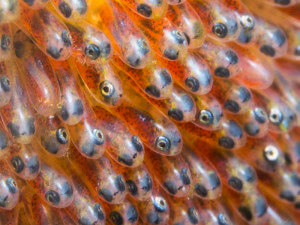
Snorkeling with reproducing anemonefish
It was several days past full moon and the tiny eggs were almost ready to hatch. The reproductive pair of anemonefish’s hard work of defending the eggs against predators and aerating them with their fins was about to pay off. Soon, thousands of tiny fish larvae will hatch and drift into the open ocean; the job of the parents would be complete. This is part of the life cycle for anemonefishes. They belong to the group of marine fishes that practice demersal spawning, a strategy where females deposit or attach unfertilized eggs onto the substrate that are subsequently fertilized by the males. Female anemonefishes nip away at edge of the oral disc of their host anemone to expose a small patch of substrate upon which to attach their egg-mass. Males fertilize the eggs and it is there that they begin their development into a new anemonefish. It can be hypothesized that using the demersal strategy reduces the risk of offspring getting eaten while developing in the open water, cast ashore, or damaged by abrasion. Parental care often consists of nest building (see above), nest cleaning, fanning, and guarding. The eggs incubate for about a week, with each parent taking turns aerating the eggs, removing non-viable ones, and defending the nest. After hatching, the tiny fish float in the ocean as part of the plankton pool where they will further develop. After about a week developing in the open ocean, they will return to the reef and seek out an anemone in which to dwell. Sounds of the reef bring the tiny fish closer to the reef and smells or chemical detection pinpoint a potential new home. Interestingly, as attached eggs on the reef, the eggs are exposed to the mucus from the host anemone’s tentacles as they brush over the egg mass. Chemicals are transferred to the embryo, as a form of ‘imprinting’, which the tiny fish can use to find their new host anemone.


